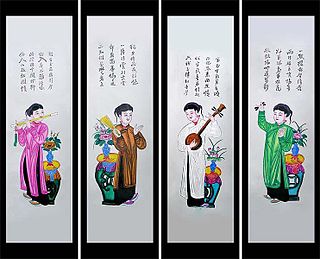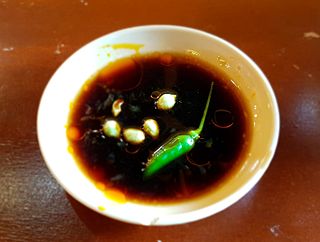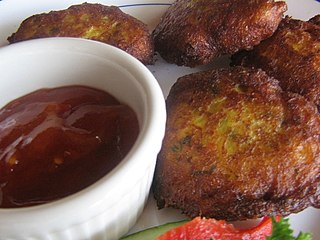
Vietnamese cuisine encompasses the foods and beverages of Vietnam. Meals feature a combination of five fundamental tastes : sweet, salty, bitter, sour, and spicy. The distinctive nature of each dish reflects one or more elements, which are also based around a five-pronged philosophy. Vietnamese recipes use ingredients like lemongrass, ginger, mint, Vietnamese mint, long coriander, Saigon cinnamon, bird's eye chili, lime, and Thai basil leaves. Traditional Vietnamese cooking has often been characterised as using fresh ingredients, not using much dairy or oil, having interesting textures, and making use of herbs and vegetables. The cuisine is also low in sugar and is almost always naturally gluten-free, as many of the dishes are rice-based instead of wheat-based, made with rice noodles, papers and flour. Vietnamese cuisine is strongly influenced not only by the cuisines of neighboring China, Cambodia and Laos, but also by French cuisine due to French colonial rule over the region from 1887 to 1954.

Chinese Indonesian cuisine is characterized by the mixture of Chinese with local Indonesian style. Chinese Indonesians, mostly descendant of Han ethnic Hokkien and Hakka speakers, brought their legacy of Chinese cuisine, and modified some of the dishes with the addition of Indonesian ingredients, such as kecap manis, palm sugar, peanut sauce, chili, santan and local spices to form a hybrid Chinese-Indonesian cuisine. Some of the dishes and cakes share the same style as in Malaysia and Singapore, known as Nyonya cuisine by the Peranakan.

The generic term for condiments in the Filipino cuisine is sawsawan. Unlike sauces in other Southeast Asian regions, most sawsawan are not prepared beforehand, but are assembled on the table according to the preferences of the diner.

Korean Chinese cuisine, also known as Sino–Korean cuisine, is a hybrid cuisine developed by the ethnic Chinese in Korea.

Chili sauce and chili paste are condiments prepared with chili peppers.

Indian Chinese cuisine, Chinese Indian cuisine, Sino-Indian cuisine, Chindian cuisine, Hakka Chinese or Desi-Chinese cuisine is a distinct style of Chinese cuisine adapted to Indian tastes, combining Chinese foods with Indian flavours and spices. Though Asian cuisines have mixed throughout history throughout Asia, the most popular origin story of the fusion food resides with Chinese labourers of Calcutta, who immigrated to British Raj India looking for work. Opening restaurant businesses in the area, these early Chinese food sellers adapted their culinary styles to suit Indian tastes.

Jangajji (장아찌) or pickled vegetables is a type of banchan made by pickling vegetables. Unlike kimchi, jangajji is non-fermented vegetables, usually pickled in soy sauce, soybean paste, or chili paste. Jangajji dishes are usually preserved for a long period of time, and served with a drizzle of sesame oil. Preserved foods like jangajji were developed to attain a certain level of vegetable consumption during the long, harsh winters on the Korean peninsula.

Gejang (Korean: 게장) or gejeot (게젓) is a variety of jeotgal, salted fermented seafood in Korean cuisine, which is made by marinating fresh raw crabs either in ganjang or in a sauce based on chili pepper powder. The term consists of the two words; ge, meaning "a crab", and jang which means "condiment" in Korean. The crab selected for Gejang dish are mostly female crab with eggs. Although gejang originally referred only to crabs marinated in soy sauce, it has begun to be called ganjang-gejang (Korean: 간장게장) these days to differentiate it from yangnyeom-gejang (양념게장). The latter is a relatively new dish that emerged since the restaurant industry began to thrive in South Korea. "Yangnyeom" literally means "seasoning" or "seasoned" in Korean but refers to the spicy sauce made with chili pepper powder.

Yuxiang shredded pork is a common dish in Sichuan cuisine. Yuxiang is one of the main traditional flavors in Sichuan.

Hot and sour soup is a popular example of Sichuan cuisine. Similar versions are found in Henan province, near Beijing, and in Henan cuisine itself, where it may also be known as hulatang or "pepper hot soup" (胡辣汤). Also popular in Southeast Asia, India, Pakistan and the United States, it is a flexible soup which allows ingredients to be substituted or added depending on availability. For example, the American-Chinese version can be thicker as it commonly includes corn starch, whilst in Japan, sake is often added.

Kung Pao chicken, also transcribed Gong Bao or Kung Po, is a spicy, stir-fried Chinese dish made with cubes of chicken, peanuts, vegetables and chili peppers. The classic dish in Sichuan cuisine originated in the Sichuan province of south-western China and includes Sichuan peppercorns. Although the dish is found throughout China, there are regional variations that are typically less spicy than the Sichuan serving.

Chili oil is a condiment made from vegetable oil that has been infused with chili peppers. Different types of oil and hot peppers are used, and other components may also be included. It is commonly used in Chinese cuisine, Southeast Asian cuisine, Italy, and elsewhere. It is particularly popular in western Chinese cuisines such as Sichuan cuisine, Hunan cuisine, Guizhou cuisine, and Shaanxi cuisine where it is used as an ingredient in cooked dishes as well as a condiment. It is sometimes used as a dip for meat and dim sum. It is also employed in the Korean Chinese noodle soup dish jjamppong.

Mala is a spicy and numbing seasoning made from Sichuan peppercorn and chilli. Most commonly, mala is made into a sauce by simmering it in oil and other spices. Characteristic of Sichuan cuisine, particularly Chongqing cuisine, it has become one of the most popular ingredients in Chinese cuisine, spawning many regional variants.

Mapo tofu is a popular Chinese dish from Sichuan province. It consists of tofu set in a spicy sauce, typically a thin, oily, and bright red suspension, based on douban, and douchi, along with minced meat, traditionally beef. Variations exist with other ingredients such as water chestnuts, onions, other vegetables, or wood ear fungus. One account indicates that the dish existed as early as 1254, in a suburb of Chengdu, the capital city of Sichuan. Other accounts indicate it originated at a Chengdu restaurant in the 1860s.

Sambal is an Indonesian chili sauce or paste, typically made from a mixture of a variety of chilli peppers with secondary ingredients such as shrimp paste, garlic, ginger, shallot, scallion, palm sugar, and lime juice. Sambal is an Indonesian loanword of Javanese origin. It originated from the culinary traditions of Indonesia and is also an integral part of the cuisines of Singapore, Malaysia, Brunei, and Sri Lanka. It has also spread through overseas Indonesian populations to the Netherlands and Suriname.

Teochew porridge is a Teochew rice porridge dish often accompanied with various small plates of side dishes. Teochew porridge is served as a banquet of meats, fish egg, and vegetables that is eaten with plain rice porridge. It may be simply prepared plain, or include sweet potatoes. The rice grains, while softened from cooking, are still whole and not in an overly starchy state. Because the porridge is served plain, it is suitable to accompany salty side dishes. The recipe originated in Chaozhou and was later modified by early immigrants prepared in Malaysia and Singapore over the generations to suit local tastes.


















